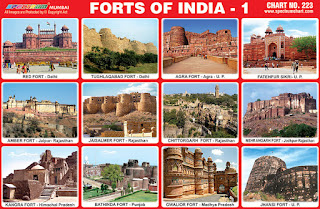Red Fort (Delhi) - Red Fort
was the residence of the Mughal emperor for nearly 200 years, until
1857. It is located in the centre of Delhi and houses a number of
museums. Constructed in 1648 by the fifth Mughal Emperor Shah Jahan
as the palace of his fortified capital Shahjahanabad, the Red Fort
is named for its massive enclosing walls of red sandstone. It is
designated as a UNESCO World Heritage Site as part of the Red Fort
Complex. On Independence Day (15 August), the Prime Minister of
India hoists the 'tricolour' national flag at the main gate of the
fort and delivers a nationally-broadcast speech from its ramparts.
Tughlaqabad Fort (Delhi) -
Tughlaqabad Fort is a ruined fort in Delhi, stretching over 6 km
built by Ghiyas-ud-din Tughlaq, the founder of Tughlaq dynasty, of
the Delhi Sultanate of India in 1321. Tughluqabad fort consists of
remarkable, massive stone fortifications that surround the irregular
ground plan of the city.
Agra Fort (Agra, Uttar Pradesh)
– Agra Fort is a UNESCO World Heritage site located in Agra. It is
about 2.5 km northwest of its more famous sister monument, the Taj
Mahal. The fort can be more accurately described as a walled city.
The 94 acre fort has a semicircular plan, its chord lies parallel to
the river and its walls are seventy feet high.
Fatehpur Sikri (Uttar Pradesh)
- Fatehpur Sikri was made the political capital of the Mughal
Empire by Emperor Akbar from the period of 1571 to 1585. Fort is a
blend of Mughal and Persian architecture. Fatehpur Sikri is
considered as one of the architectural legacies of Emperor Akbar. It
consists of beautiful palaces, halls and mosques.
Amber Fort (Jaipur, Rajasthan)
- Amber Fort, is located in Amer, a town with an area of 4 sq. km
located 11 km from Jaipur. Located high on a hill, it is the
principal tourist attraction in the Jaipur area. Amber Fort is known
for its artistic Hindu style elements. With its large ramparts and
series of gates and cobbled paths, the fort overlooks Maota Lake.
Amber fort is a UNESCO World Heritage Site as part of the group Hill
Forts of Rajasthan.
Jaisalmer Fort (Jaisalmer,
Rajasthan) - Jaisalmer Fort is one of the largest fortifications
in the world. It is a World Heritage Site. It was built in 1156 AD
by the Rajput ruler Rawal Jaisal. The fort stands amidst the sandy
expanse of the great Thar Desert, on Trikuta Hill and has been the
scene of many battles. The fort is 1,500 ft long and 750 ft wide and
is built on a hill that raises above a height of 250 ft above the
surrounding country side. The basement of the fort has a 15 ft tall
wall forming a double line of defence.
Chittorgarh Fort (Chittorgarh,
Rajasthan) - Chittorgarh Fort is one of the largest forts in
India. It is a World Heritage Site. The fort, popularly known as
Chittor, was the capital of Mewar and is today situated in
Chittorgarh. Chittorgarh Fort is stated that the fort was
constructed by the Mauryans during the 7th century AD.
Mehrangarh Fort (Jodhpur,
Rajasthan) - Mehrangarh Fort located in Jodhpur is one of the
largest forts in India. Built around 1460 by Rao Jodha, the fort is
situated 410 feet above the city and is enclosed by imposing thick
walls. The museum in the Mehrangarh fort is one of the most
well-stocked museums in Rajasthan.
Kangra Fort (Kangra, Himachal
Pradesh) – The Kangra Fort is located on the outskirts of the
town of Kangra in Himachal Pradesh. Kangra Fort was built by the
royal Rajput family of Kangra State. It is the largest fort in the
Himalayas and probably the oldest dated fort in India.
Bathinda Fort (Batinda, Punjab)
– Bathinda Fort (Qila Mubarak) is a historical monument in the
heart of the city of Bathinda in Punjab. It has been in existence
from 90-110 AD. It was here that Razia Sultan, the first woman to
take charge of the Delhi throne was incarcerated on her defeat and
dethroned. The bricks of the fort date back to the Kushana period
when emperor Kanishka ruled over Northern India.
Gwalior Fort (Gwalior, Madhya
Pradesh) - Gwalior Fort is an 8th-century hill fort near Gwalior
in central India. The fort consists of a defensive structure and two
main palaces. The fort has been controlled by a number of different
rulers in its history. The fort premises house many historic
monuments including palaces, temples and water tanks. The fort
covers an area of 3 sq. km and rises 35 feet.
Jhansi Fort (Jhansi, Uttar
Pradesh) - Jhansi Fort is a fortress situated on a large hilltop
called Bangira, in Uttar Pradesh. It served as a stronghold of the
Chandela Kings in Balwant Nagar from the 11th through the 17th
century. The fort extends to a sprawling 15 acres and this colossal
structure measures about 312 m in length and 225 m in width. Rani
Laxmi Bai used the fort as her residence. In 1858 she led Jhansi
forces against the British East India Company.


No comments:
Post a Comment